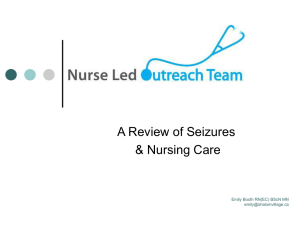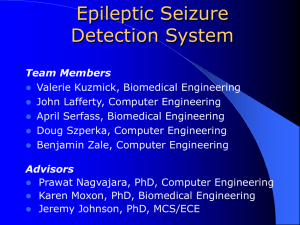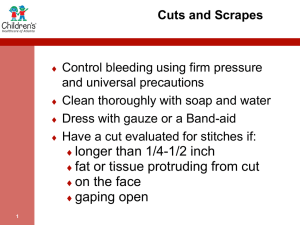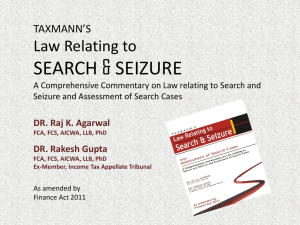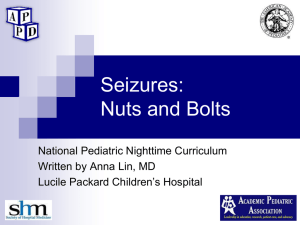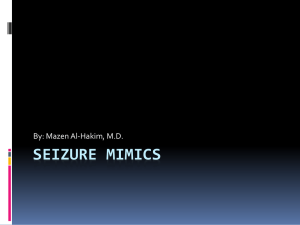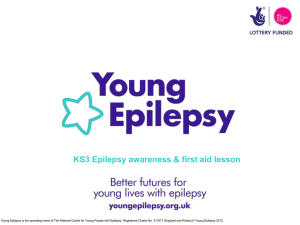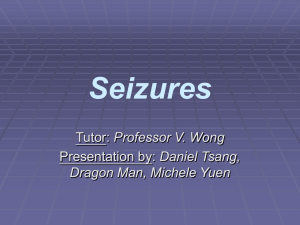Seizure_Disorders - Albemarle County Public Schools
advertisement
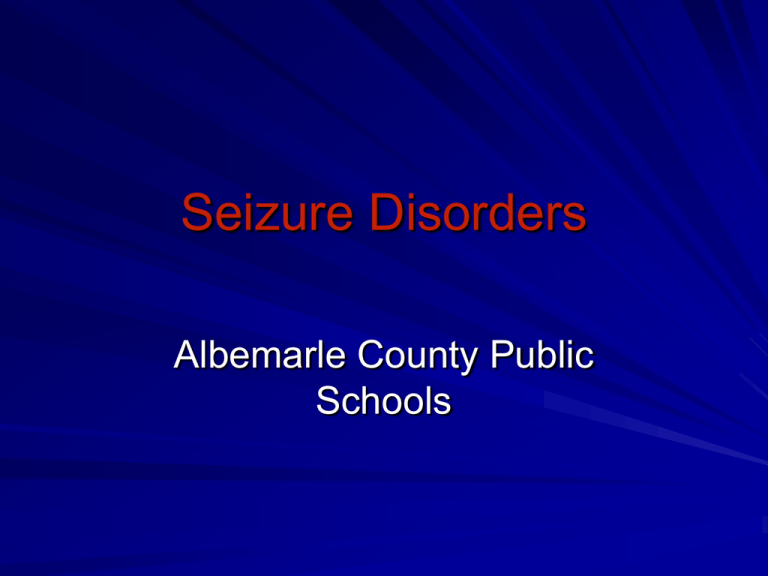
Seizure Disorders Albemarle County Public Schools What is a Seizure? An event in which there is a temporary change in behavior resulting from a sudden, abnormal burst of electrical activity in the brain or change in the normal brain waves. Generalized seizure: occurs when the disturbance affects the entire brain. Partial seizure: occurs when the disturbance affects only one area of the brain. Generalized Seizures: Tonic-Clonic Usually lasts 2 – 3 minutes May have aura or warning before Eyes roll upward Loss of consciousness and falls to ground Becomes rigid as the muscles tighten Followed by jerking movements of the entire body as muscles undergo rhythmic tightening and relaxing May become incontinent, breathing may be shallow or stop briefly, person is usually drowsy afterwards Generalized Seizures: Absence or Petit Mal Brief loss of consciousness with little or no alteration in muscle tone May go unnoticed May include “blank stare” for 5 to 10 seconds May drop an object as lose muscle tone May have minor movements such as lip smacking or twitching Inability to recall what happened afterwards Generalized Seizures: Atonic Sudden, momentary loss of muscle tone May or may not lose consciousness May be mild such as brief head drop or Severe: fall to ground, lose consciousness briefly, then get up as though nothing happened Partial Seizures: Simple Manifestations depend on area of brain affected. May or may not lose consciousness or be aware of seizure. Example: eyes or eyes and head may turn to one side and the arm on that side may be extended with fingers clenched. Partial Seizures: Complex Most common type. May begin with aura such as odd taste or smell and/or visual hallucinations. May cry out then suddenly become unaware of surroundings and unable to respond. May become limp or stiff and appear dazed, confused and apathetic. Basic Seizure Management Protect student Observe: Note which parts of body involved and duration. Get medical assistance when needed: A series of seizures without regaining consciousness or a seizure lasting longer than 5 minutes can be a medical emergency. Managing a Seizure in the School Setting Each student with a known seizure disorder should have a Seizure Action Plan* on file in the school health office. Procedure for Managing a Seizure 1. 2. 3. 4. 5. 6. 7. 8. If student has a known seizure disorder, follow plan. Remain calm – seizure can’t be stopped once it starts. Have an adult monitor the student. Note exact time of onset. Put on gloves, if available. Place student on side. If possible, put something soft under student’s head. Do not place anything in student’s mouth. Document: time seizure began, body part involved and any movement from one part to another, type of movements of head, face, arms. Call Emergency Medical Services 911 if: Student stops breathing There is evidence of injury Student is diabetic or pregnant Seizure lasts more than 5 minutes Pupils are not equal in size after seizure Student cannot be awakened after seizure Student vomits continuously after seizure This is student’s first seizure After Seizure 1. 2. 3. 4. 5. 6. 7. 8. Monitor breathing. Check position of head and tongue. Determine level of awareness. Note if alert, confused, drowsy, etc. Determine if student is able to move limbs. Check for injuries and provide care if needed. If student remains unconscious maintain open airway and continue to assess. Check for loss of control of urine and stool. Provide comfort measures. Document length of seizure and what happened during and after. Call or have someone call parents promptly. Rectal Diazepam Some students with known seizure disorders have a medication prescribed by a doctor to be administered if the seizure lasts more than 5 minutes. This must be in the student’s care plan with both parent and physician signatures. Procedure for Administering Rectal Diazepam (Diastat) at School 1. 2. 3. 4. 5. 6. 7. 8. 9. 10. Don gloves. Obtain assistance of other adult, if possible. Remove protective cover from the medication syringe and lubricate the rectal tip with the jelly in the package. Turn student on side (left preferably) facing you. Bend the upper leg forward and separate the buttocks to expose the rectum. Gently insert the syringe tip into the rectum. The rim should be snug against the opening. Slowly count to three while gently pushing in the plunger. Count to 3 again before removing. Hold the buttocks together and count to 3 again. Keep student on side and note the time. 9-1-1 must be called when diastat is given at school. Observe for side effects. Remove gloves and wash hands. See following slides for simplified pictorial instructions Diastat* Instructions Delegate call to 911. Check orders and care plan. Clear area of students and on lookers. Put on gloves. If student is in a wheelchair or car/bus seat child to ground. Follow instructions on following slides. Call or delegate call to parents after diastat is administered. *Diastat information obtained from Valeant Pharmaceutical and is included here with permission for educational purposes only. See http://www.diastat.com/HTML-INF/index.htm for additional information. Diastat Instructions 1. Put student on side he/she where can’t fall. 2. Get the diastat kit. 3. Get syringe. Note: Seal pin is attached to cap. Check dose in dial window. Diastat Instructions 4. Push up with thumb and pull to remove cap from syringe. Be sure seal pin is removed. 5. Lubricate rectal tip with lubricating jelly. 6. Turn student on side facing you. Diastat Instructions 7. Bend upper leg forward to expose rectum. 8. Separate buttocks to expose rectum. 9. Gently insert syringe tip into rectum. Rim should be snug against rectal opening. Diastat Instructions 10. Slowly count to 3 while gently pushing plunger until it stops. 11. Slowly count to 3 before removing syringe. 12. Slowly count to 3 while holding buttocks together. 13. Keep student on side facing you, note time and continue to observe. Diastat Instructions Disposal Instructions: For AcuDial: After 14a put syringe in box or bag and give to rescue squad personnel. For 2.5 mg syringe put syringe in box or bag and give to rescue squad personnel. How to Administer Diastat Video For a video demonstration on administering Diastat go to: http://www.diastat.com/HTMLINF/Admin_Diastat/Admin_Diastat/How_to _Administer_Video.htm

